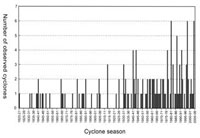
Insights provided by a historical database of tropical cyclones and their impacts in the Cook Islands
Dr. Fes de Scally, University of British Columbia-Okanagan, Canada
Historical tropical cyclone activity
Since 1820 at least 143 tropical cyclones have occurred inside the Cook Islands’ 200 nautical mile Exclusive Economic Zone (EEZ). Since 1970 when satellite imagery has allowed comprehensive monitoring of tropical cyclones, a total of 65 cyclones have affected the Cook Islands. This is an average of 1.8 cyclones every season. Twenty of these became hurricanes (sustained winds of at least 119 km/hr), an average of one hurricane about every two years. The Southern Group has experienced more than twice as many cyclones as the Northern Group, with the island of Palmerston most affected on account of its proximity to the typical cyclone track through the Cooks’ EEZ.
February alone accounts for 29% of all datable cyclone occurrences since 1820. While only 4% of cyclones haveoccurred outside the 1 November to 30 April cyclone season, the devastation of Cyclone Martin in 1997 demonstrates the importance of preparedness during this time. Cyclones achieving hurricane status have all occurred during the December-April period, with 38% occurring in February.
Only nine seasons since 1970 have experienced no cyclone activity in the Cook Islands, while another nine have experienced between three and six cyclones. The sudden increase in the number of seasons with three or more cyclones in the mid-1970s very likely reflects the beginning of improved monitoring with satellites. All six cyclones since1970 which reached major hurricane intensity inside the Cooks’ EEZ have occurred in the last four seasons, possibly reflecting a recent increase in the number of very intense cyclones in the Southwest Pacific1. Between 1870 and 1969, 48% of cyclones in the Cook Islands occurred during El Ninoevents; this proportion has increased to 56% since 1970.
Historical tropical cyclone impacts
Since 1820 at least 91 tropical cyclones have impacted the inhabitants of the Cook Islands in some way. Beginning with relatively complete reporting in 1891, cyclones producing minor damage or disruptions have occurred on average about every 1½ years. Those resulting in major damage or fatalities have occurred on average about once every nine years. These represent minimum estimates, since some cyclones’ impacts may not have been recorded. Ninety-one percent of cyclones producing significant damage and disruption have struck the Southern Group, while only 42% have struck the Northern Group. Noteworthy is the large monetary cost of some recent cyclones, especially in relation to the small size of the national economy. For example, losses in Cyclone Sally in 1986-87 reached as high as NZ$55 million, while the over NZ$35 million in losses incurred in Cyclones Meena, Nancy, Olaf, and Percy in 2005 represent 14% of the country’s GDP at the time. The costs of disaster mitigation need to be weighed against such potentially high costs.
Cyclone fatalities numbered in the hundreds or even thousands for some 19th century and earlier cyclones. In contrast, only six cyclone deaths were recorded between 1891 and 1997. In 1997 Cyclone Martin resulted in 19 fatalities at Manihiki when a storm surge inundated that atoll. This disaster underscores the critical importance of providing properly constructed cyclone shelters and timely warnings for inhabitants of the Northern Group atolls (and Palmerston atoll in the Southern Group).
Lead author, A History of Tropical Cyclones and Their Impacts in the Cook Islands, Cook Islands Meteorological Service, 2006, 377 p. 1 Webster, P.J., Holland, G.J., Curry, J.A. and Chang, H-R., 2005: Changes in tropical cyclone number, duration, and intensity in a warming environment. Science 309: 1844-1846.
